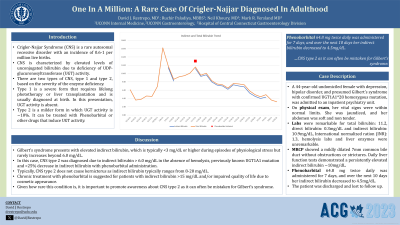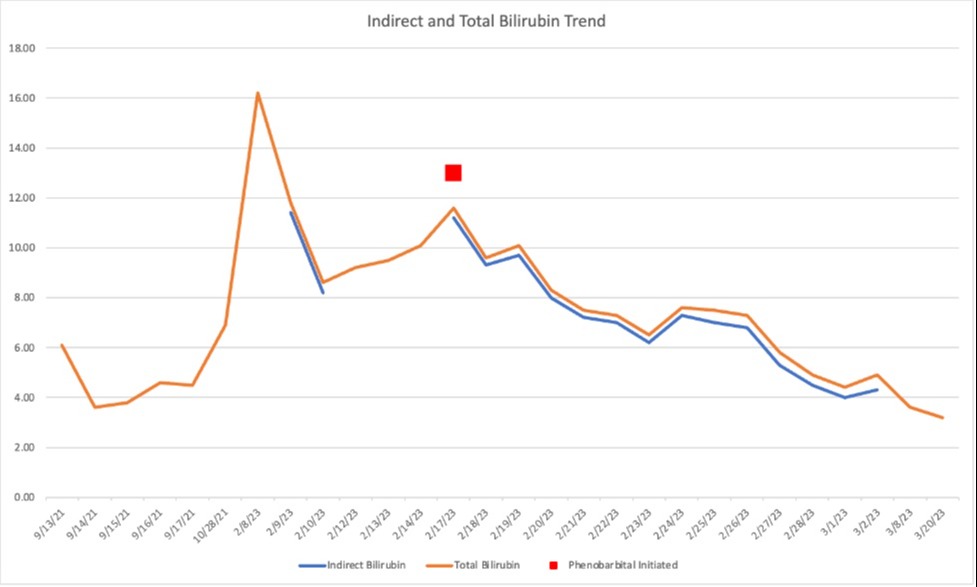Sunday Poster Session
Category: Liver
P1010 - A Rare Case of Crigler-Najjar Diagnosed in Adulthood: One in a Million
Sunday, October 22, 2023
3:30 PM - 7:00 PM PT
Location: Exhibit Hall


David Restrepo, MD
University of Connecticut
Farmington, Connecticut
Presenting Author(s)
David Restrepo, MD1, Ruchir Paladiya, MBBS2, Neil Khoury, MD3, Mark R. Versland, MD4
1University of Connecticut, Farmington, CT; 2UConn Health, Hartford, CT; 3UConn Health, West Hartford, CT; 4CTGI, New Britain, CT
Introduction: Crigler-Najjar Syndrome (CNS) is a rare autosomal recessive disorder with an incidence of 0.6-1 per million live births. It is characterized by elevated levels of unconjugated bilirubin due to deficiency of UDP-glucuronosyltransferase (UGT) activity. There are two types of CNS, type 1 and type 2, based on the severity of the enzyme deficiency. Type 1 is a severe form that requires lifelong phototherapy or liver transplantation and is usually diagnosed at birth. In this presentation, UGT activity is absent. Type 2 is a milder form in which UGT activity is ~10%. It can be treated with Phenobarbital or other drugs that induce UGT activity.
Case Description/Methods: A 44-year-old undomiciled female with depression, bipolar disorder, and presumed Gilbert’s syndrome with confirmed UGT1A1*28 homozygous mutation, was admitted to an inpatient psychiatry unit. On physical exam, her vital signs were within normal limits. She was jaundiced, and her abdomen was soft and nontender. Labs were remarkable for total bilirubin: 11.2, direct bilirubin: 0.3mg/dL and indirect bilirubin: 10.9mg/dL, International normalized ration (INR): 1.3, hemolysis labs and liver enzymes were unremarkable. MRCP showed a mildly dilated 7mm common bile duct without obstructions or strictures. Daily liver function tests demonstrated a persistently elevated indirect bilirubin ~10mg/dL. Phenobarbital 64.8 mg twice daily was administered for 7 days, and over the next 10 days her indirect bilirubin decreased to 4.5mg/dL. The patient was discharged and lost to follow up.
Discussion: Gilbert's syndrome presents with elevated indirect bilirubin, which is typically < 3 mg/dL or higher during episodes of physiological stress but rarely increases beyond 6.0 mg/dL. In this case, CNS type 2 was diagnosed due to indirect bilirubin > 6.0 mg/dL in the absence of hemolysis, previously known UGT1A1 mutation and >25% decrease in indirect bilirubin with phenobarbital administration. Typically, CNS type 2 does not cause kernicterus as indirect bilirubin typically ranges from 8-20 mg/dL. Chronic treatment with phenobarbital is suggested for patients with indirect bilirubin >15 mg/dL and/or impaired quality of life due to cosmetic appearance. Given how rare this condition is, it is important to promote awareness about CNS type 2 as it can often be mistaken for Gilbert’s syndrome.

Disclosures:
David Restrepo, MD1, Ruchir Paladiya, MBBS2, Neil Khoury, MD3, Mark R. Versland, MD4. P1010 - A Rare Case of Crigler-Najjar Diagnosed in Adulthood: One in a Million, ACG 2023 Annual Scientific Meeting Abstracts. Vancouver, BC, Canada: American College of Gastroenterology.
1University of Connecticut, Farmington, CT; 2UConn Health, Hartford, CT; 3UConn Health, West Hartford, CT; 4CTGI, New Britain, CT
Introduction: Crigler-Najjar Syndrome (CNS) is a rare autosomal recessive disorder with an incidence of 0.6-1 per million live births. It is characterized by elevated levels of unconjugated bilirubin due to deficiency of UDP-glucuronosyltransferase (UGT) activity. There are two types of CNS, type 1 and type 2, based on the severity of the enzyme deficiency. Type 1 is a severe form that requires lifelong phototherapy or liver transplantation and is usually diagnosed at birth. In this presentation, UGT activity is absent. Type 2 is a milder form in which UGT activity is ~10%. It can be treated with Phenobarbital or other drugs that induce UGT activity.
Case Description/Methods: A 44-year-old undomiciled female with depression, bipolar disorder, and presumed Gilbert’s syndrome with confirmed UGT1A1*28 homozygous mutation, was admitted to an inpatient psychiatry unit. On physical exam, her vital signs were within normal limits. She was jaundiced, and her abdomen was soft and nontender. Labs were remarkable for total bilirubin: 11.2, direct bilirubin: 0.3mg/dL and indirect bilirubin: 10.9mg/dL, International normalized ration (INR): 1.3, hemolysis labs and liver enzymes were unremarkable. MRCP showed a mildly dilated 7mm common bile duct without obstructions or strictures. Daily liver function tests demonstrated a persistently elevated indirect bilirubin ~10mg/dL. Phenobarbital 64.8 mg twice daily was administered for 7 days, and over the next 10 days her indirect bilirubin decreased to 4.5mg/dL. The patient was discharged and lost to follow up.
Discussion: Gilbert's syndrome presents with elevated indirect bilirubin, which is typically < 3 mg/dL or higher during episodes of physiological stress but rarely increases beyond 6.0 mg/dL. In this case, CNS type 2 was diagnosed due to indirect bilirubin > 6.0 mg/dL in the absence of hemolysis, previously known UGT1A1 mutation and >25% decrease in indirect bilirubin with phenobarbital administration. Typically, CNS type 2 does not cause kernicterus as indirect bilirubin typically ranges from 8-20 mg/dL. Chronic treatment with phenobarbital is suggested for patients with indirect bilirubin >15 mg/dL and/or impaired quality of life due to cosmetic appearance. Given how rare this condition is, it is important to promote awareness about CNS type 2 as it can often be mistaken for Gilbert’s syndrome.

Figure: Direct and indirect bilirubin trend before and after initiation of Phenobarbital
Disclosures:
David Restrepo indicated no relevant financial relationships.
Ruchir Paladiya indicated no relevant financial relationships.
Neil Khoury indicated no relevant financial relationships.
Mark Versland indicated no relevant financial relationships.
David Restrepo, MD1, Ruchir Paladiya, MBBS2, Neil Khoury, MD3, Mark R. Versland, MD4. P1010 - A Rare Case of Crigler-Najjar Diagnosed in Adulthood: One in a Million, ACG 2023 Annual Scientific Meeting Abstracts. Vancouver, BC, Canada: American College of Gastroenterology.
